Scope of Local Variables
In this chapter, you will learn about the visibility of local variables.

Scope
The focus is on using language constructs such as def, class and module and how it affects the visibility.
At the Top Level
Visibility of Local Variable
Let's look at an example where we have a local variable at the top level and see if we can access it inside a top level method.
x = 1
p x
def test
p x
end
test
This prints 1 and then the error.
NameError: undefined local variable or method ‘x’ for main:Object
Thus, we can see that the top level local variable x is not accessible inside the top level method.

We can verify this fact by asking Ruby.
x = 1
p "Local variables at the top level : #{local_variables}"
def test
p "Local variables inside the test method : #{local_variables}"
end
test
This prints:
Local variables at the top level : [:x]
Local variables inside the test method : []
This shows that at the top level, there is a local variable x, whereas, inside the top level method, there is none. This is an example where self does not change but scope changes.
Any variables defined within a method goes out of scope when we exit the method. The local variable is garbage collected. For instance, any variable defined in a learn method is not available outside of that method.

The diagram illustrates the life time of a variable defined within a method.
Inside a Top Level Method
Local Variables in Different Scopes
What happens if we define a local variable inside the top level method? Let's write a simple program that defines local variable at the top level and inside a top level method.
x = 1
p "At top level x is : #{x}"
def test
x = 2
p "Inside the top level method x is : #{x}"
end
test
p "Back at the top level x is : #{x}"
This prints:
At top level x is : 1
Inside the top level method x is : 2
Back at the top level x is : 1
Top level has its own scope. The method definition has its own scope.

That's why we see x is 1 at top level and it is 2 inside the method definition. The variable names are the same. However, the x at the top level and the x inside the method are variables in different scopes. Thus, they are different.
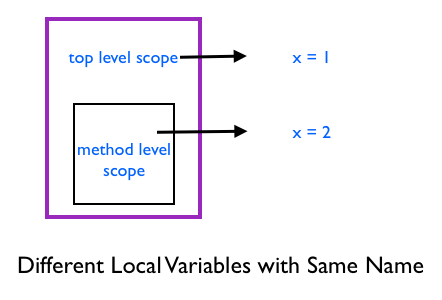
This is an example where self does not change, but scope changes. We know that the self is main at the top level as well as inside the method.
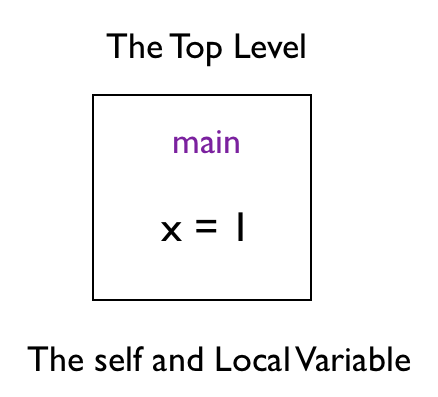
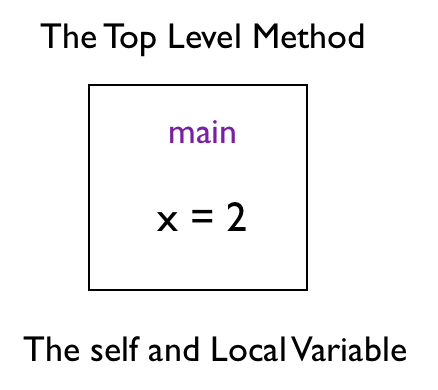
Let's trace the local variables in different scopes as the program executes.
x = 1
p "At the top level local variables:"
p local_variables
def test
x = 2
p "Inside the top level method, local variables:"
p local_variables
end
test
This prints:
At the top level local variables:
[:x]
Inside the top level method, local variables:
[:x]
The name of the local variables is the same. From the previous experiment we know they are different.
Inside a Class
Visibility of Local Variable
What happens when we try to access a local variable defined at the top level from a class?
x = 1
class A
p x
end
This gives us the error:
NameError: undefined local variable or method ‘x’ for A:Class
The local variable x defined at the top level is not visible within the class.

This is an example where both self and scope changes.
Local Variables in Different Scopes
Let's write a simple program that defines a local variable at the top level and inside a class.
x = 1
p "At the top level, x is #{x}"
class A
x = 2
p "Inside the class, x is : #{x}"
end
p "Back at the top level, x is #{x}"
This prints:
At the top level, x is 1
Inside the class, x is : 2
Back at the top level, x is 1
The value of x inside the class is different from the x at the top level. Variables inside the class have its own scope. The x at the top level is different from the x inside the class.

This is an example where both self and scope changes. The self at the top level is main and the self inside the class is A.
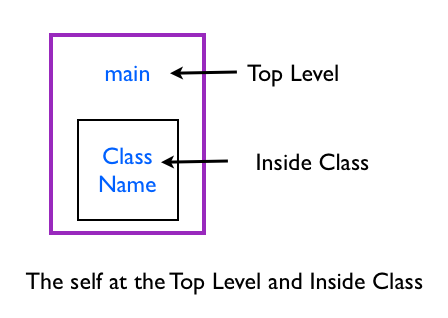
Let's trace the local variables.
x = 1
p "Local variables at the top level : #{local_variables}"
class A
x = 2
p "Local variables inside the class : #{local_variables}"
end
This prints:
Local variables at the top level : [:x]
Local variables inside the class : [:x]
The name of the local variable is the same. But they are different because they belong to different scopes. The first one belongs to the top level and the second one belongs to the method level scope.

Let's take a look an example.
x = 1
p "Local variables at the top level : #{x}"
class A
x = 2
p "Local variables inside the class : #{x}"
end
p "Local variables at the top level : #{x}"
This prints:
Local variables at the top level : 1
Local variables inside the class : 2
Local variables at the top level : 1
Inside a Module
Visibility of Local Variable
What happens when we try to access a local variable defined at the top level from a module?
x = 1
module B
p x
end
This gives us the error:
NameError: undefined local variable or method ‘x’ for B:Module
The local variable x defined at the top level is not visible within the module.
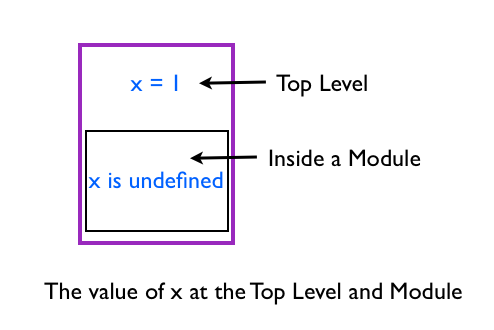
This is an example where both self and scope changes.
Local Variables in Different Scopes
Let's write a simple program that defines local variable at the top level and inside a module.
x = 1
p "At the top level, x is : #{x}"
module B
x = 2
p "Inside the module, x is : #{x}"
end
p "Back at the top level, x is : #{x}"
This prints:
At the top level, x is : 1
Inside the module, x is : 2
Back at the top level, x is : 1
The variables inside Module also have its own scope.
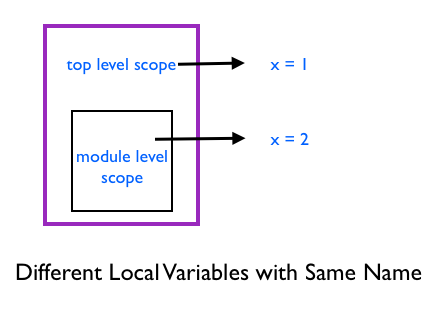
The self and scope both change in this example. The self is main at the top level and the self is B inside the module.
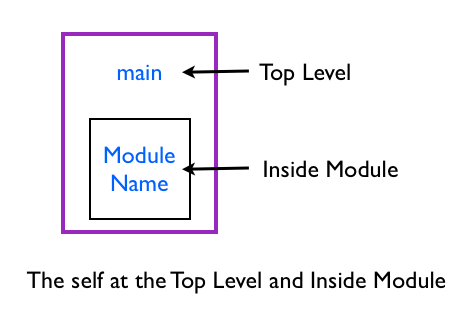
Discovery Exercise
Write a program to trace the local variables for the above example.
The Grand Example
Let's combine top level, class definition and method definition into one example.
x = 1
p "At the top level, x is : #{x}"
def test
x = 2
p "Inside top level method, x is : #{x}"
end
test
class A
x = 3
p "Inside the class, x is : #{x}"
end
module B
x = 4
p "Inside the module, x is : #{x}"
end
p "Back at the top level, x is : #{x}"
This prints:
At the top level, x is : 1
Inside top level method, x is : 2
Inside the class, x is : 3
Inside the module, x is : 4
Back at the top level, x is : 1
We see that top level, top level method, class and module have their own scopes and the value of x is specific to their own scope.

In the last example, does the self and scope change together? If so, what are their values as the program executes?

Here is a summary of how self and scope changes.
| Self | Scope | Where |
|---|---|---|
| No Change | Changes | Top Level and Top Level Method |
| Changes | Changes | Top Level and Inside Class |
| Changes | Changes | Top Level and Inside Module |
Summary
In this chapter, we experimented with the scope of variables in four different scenarios.
- At top level scope
- Method definition scope
- Class definition scope
- Module definition scope
We found that each of these, have their own local variables. The class, module or def keyword creates a new local scope.